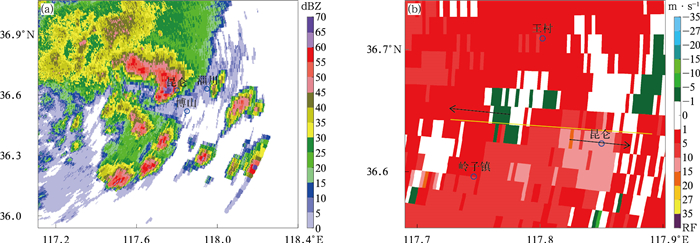|
[1]
|
Fujita T T.Manual of Downburst Identification for Project NIMROD.SMRP Research Paper156.Chicago: University of Chicago, 1978: 1-104.
|
|
[2]
|
Zheng Y G, Zhou K H, Sheng J, et al. Advances in techniques of monitoring, forecasting and warning of severe convective weather. J Appl Meteor Sci, 2015, 26(6): 641-657. doi: 10.11898/1001-7313.20150601 |
|
[3]
|
|
|
[4]
|
|
|
[5]
|
Gao X M, Yu X D, Wang L J, et al. Comparative analysis of two strong convections triggered by sea-breeze front in Shandong Peninsula. J Appl Meteor Sci, 2018, 29(2): 245-256. doi: 10.11898/1001-7313.20180210 |
|
[6]
|
Wang H, Li Y, Song L L, et al. Comparison of characteristics and environmental factors of thunderstorm gales over the Sichuan-Tibet Region. J Appl Meteor Sci, 2020, 31(4): 435-446. doi: 10.11898/1001-7313.20200406 |
|
[7]
|
Wang H, Li Y, Wen Y R. Observational characteristics of a hybrid severe convective event in the Sichuan-Tibet Region. J Appl Meteor Sci, 2021, 32(5): 567-579. doi: 10.11898/1001-7313.20210505 |
|
[8]
|
|
|
[9]
|
|
|
[10]
|
|
|
[11]
|
|
|
[12]
|
Eilts M D, Johnson J T, Mitchell E D, et al. Damaging Downburst Prediction and Detection Algorithm for the WSR-88D//Preprints, 18th Conference on Severe Local Storms. San Francisco, CA, Amer Meteor Soc, 1996: 541-545.
|
|
[13]
|
|
|
[14]
|
Wang F X, Yu X D, Pei Y J, et al. Radar echo characteristics of thunderstorm gales and forecast key points in Hebei Province. J Appl Meteor Sci, 2016, 27(3): 342-351. doi: 10.11898/1001-7313.20160309 |
|
[15]
|
Wang Y T, Wang X M, Yu X D. Radar characteristics of straight-line damaging wind producing supercell storms. J Appl Meteor Sci, 2022, 33(2): 180-191. doi: 10.11898/1001-7313.20220205 |
|
[16]
|
|
|
[17]
|
|
|
[18]
|
Wu C, Liu L P, Yang M L, et al. Key technologies of hydrometeor classification and mosaic algorithm for X-band polarimetric radar. J Appl Meteor Sci, 2021, 32(2): 200-216. doi: 10.11898/1001-7313.20210206 |
|
[19]
|
Li Z, Wu C, Liu L P, et al. Error evaluation and hydrometeor classification method of dual polarization phased array radar. J Appl Meteor Sci, 2022, 33(1): 16-28. doi: 10.11898/1001-7313.20220102 |
|
[20]
|
|
|
[21]
|
Diao X G, Li F, Wan F J. Comparative analysis on dual polarization features of two severe hail supercells. J Appl Meteor Sci, 2022, 33(4): 414-428. doi: 10.11898/1001-7313.20220403 |
|
[22]
|
Kumjian M R, Ganson S M, Ryzhkov A V. Freezing of rain drops in deep convective updrafts: A microphysical and polarimetric model. J Atmos Sci, 2012, 69(12): 3471-3490.
|
|
[23]
|
|
|
[24]
|
Loney M L, Zrnić D S, Straka J M, et al. Enhanced polarimetric radar signatures above the melting level in a supercell storm. J Appl Meteor, 2002, 41(12): 1179-1194.
|
|
[25]
|
van Lier-Walqui M, Fridlind A M, Ackerman A S, et al. On polarimetric radar signatures of deep convection for model evaluation: Columns of specific differential phase observed during MC3E. Mon Wea Rev, 2016, 144(2): 737-758.
|
|
[26]
|
Wakimoto R M, Bringi V N. Dual-polarization observations of microbursts associated with intense convection: The 20 July storm during the MIST project. Mon Wea Rev, 1988, 116(8): 1521-1539.
|
|
[27]
|
Scharfenberg K A. Polarimetric Radar Signatures in Microburst-producing Thunderstorms//31st Int Conf on Radar Meteorology. Seattle: Amer Meteor Soc, 2003, 8B4.
|
|
[28]
|
Kuster C M, Heinselman P L, Schuur, T J. Rapid-update radar observations of downbursts occurring within an intense multicell thunderstorm on 14 June 2011. Wea Forecasting, 2016, 31(3): 827-851.
|
|
[29]
|
Kuster C M, Bowers B R, Carlin J T, et al. Using KDP cores as a downburst precursor signature. Wea Forecasting, 2021, 36(4): 1183-1198.
|
|
[30]
|
Wang X, Wang H L, He J X, et al. Automated recognition of macro downburst using Doppler weather radar. Atmos, 2022, 13(5). DOI: 10.3390/atmos13050672. |
|
[31]
|
Smith T M, Elmore K L, Dulin, S A. A damaging downburst prediction and detection algorithm for the WSR-88D. Wea Forecasting, 2004, 19(2): 240-250.
|
|
[32]
|
Miller P W, Mote T L. Characterizing severe weather potential in synoptically weakly forced thunderstorm environments. Nat Hazards Earth Syst Sci, 2018, 18: 1261-1277.
|
|
[33]
|
Yu X D, Wang X M, Li W L, et al. Thunderstorm and Strong Convection Nowcasting. Beijing: China Meteorological Press, 2020.
|
|
[34]
|
McCarthy J, Serafin R, Wilson J, et al. Addressing the microburst threat to aviation: Research-to-operations success story. Bull Amer Meteor Soc, 2022, 103(12). DOI: 10.1175/BAMS-D-22-0038.1. |
|
[35]
|
|
|
[36]
|
Ma S P, Wang X M, Yu X D. Environmental parameter characteristics of severe wind with extreme thunderstorm. J Appl Meteor Sci, 2019, 30(3): 292-301. doi: 10.11898/1001-7313.20190304 |
|
[37]
|
Chen S Q, Zhang L N, Yu X D, et al. Environmental conditions of three squall lines in the north part of Zhejiang Province. J Appl Meteor Sci, 2017, 28(3): 357-368. doi: 10.11898/1001-7313.20170309 |
|
[38]
|
|
|
[39]
|
Hubbert J C, Wilson J W, Weckwerth T M, et al. S-Pol's polarimetric data reveal detailed storm features (and insect behavior). Bull Amer Meteor Soc, 2018, 99(10): 2045-2060.
|
|
[40]
|
Ryzhkov A V, Kumjian M R, Ganson S M, et al. Polarimetric radar characteristics of melting hail. Part Ⅱ: Practical implications. J Appl Meteor Climatol, 2013, 52(12): 2871-2886.
|
|
[41]
|
Duan Y P, Wang D H, Liu Y. Radar analysis and numerical simulation of strong convective weather for "Oriental Star" depression. J Appl Meteor Sci, 2017, 28(6): 666-677. doi: 10.11898/1001-7313.20170603 |
|
[42]
|
Mahale V N, Zhang G F, Xue M. Characterization of the 14 June 2011 Norman, Oklahoma, downburst through dual-polarization radar observations and hydrometeor classification. J Appl Meteor Climatol, 2016, 55(12): 2635-2655.
|





 DownLoad:
DownLoad:







